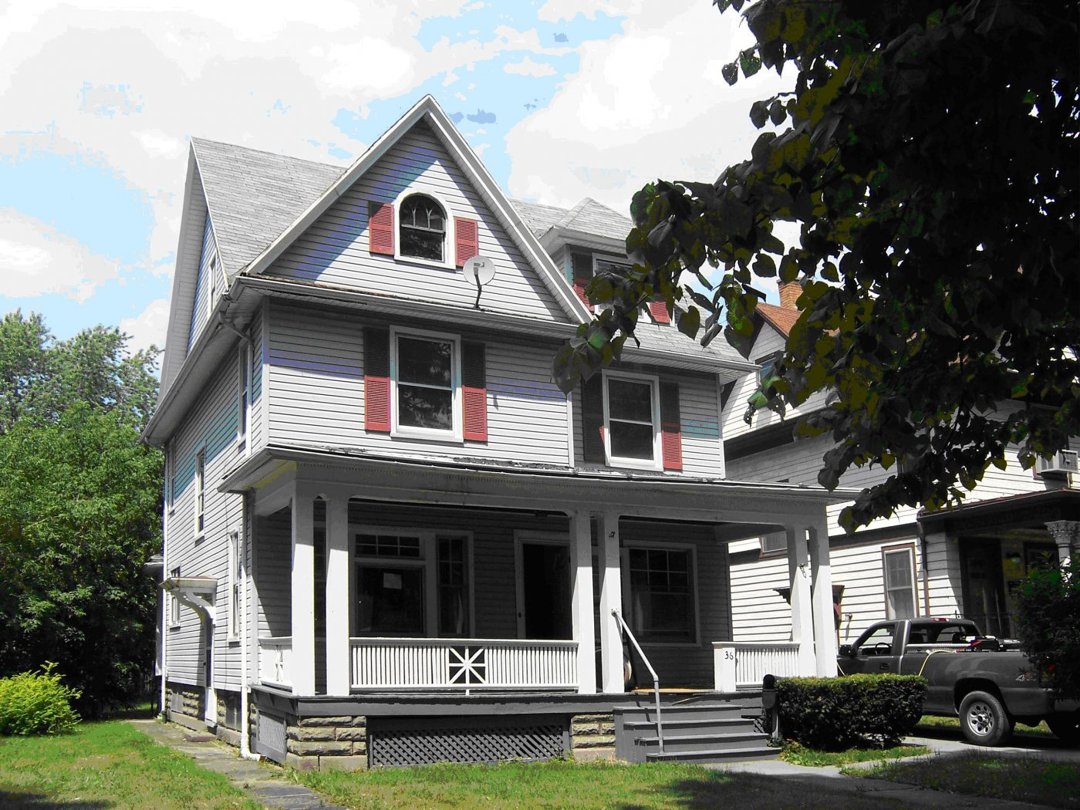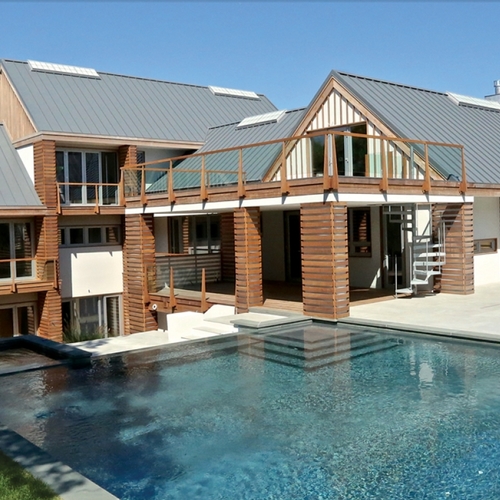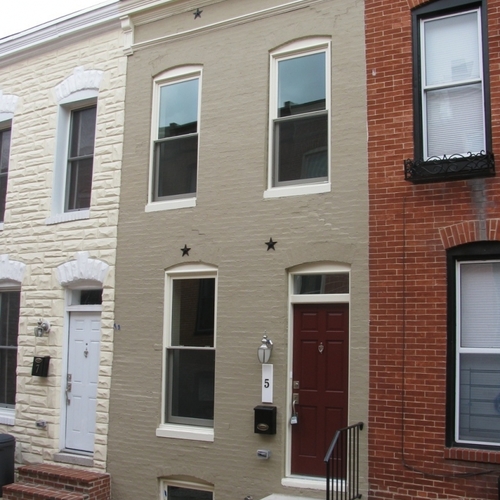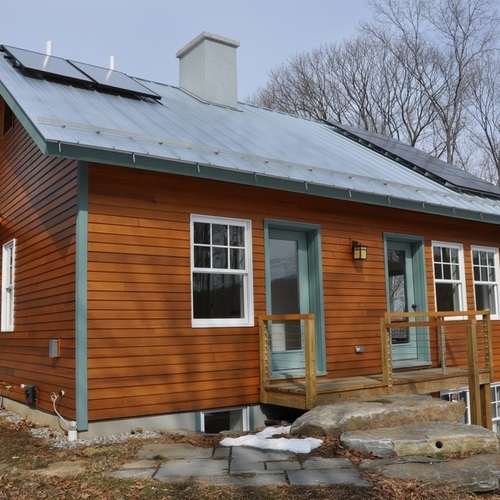
Image Credit: Armand Magnelli
Image Credit: Armand Magnelli This ranch is also one of four typical home styles in the HOME Rochester program.
Image Credit: Armand Magnelli A representative 2-story Colonial Home Rochester project. The next set of interior photos are all taken from this project.
Image Credit: Armand Magnelli Typical main bath prior to green HOME Rochester rehabilitation.
Image Credit: Armand Magnelli Typical green HOME Rochester after rehab - low flow faucets and showerheads, low flow toilet, new high performance replacement window, Energy Star light and exhaust fan.
Image Credit: Armand Magnelli Typical 2nd floor bedroom, awaiting a new floor finish, paint throughout, and insert windows.
Image Credit: Armand Magnelli Rehabbed 2nd floor bedroom with low-VOC floor finish, low-VOC paint, Energy Star lighting and high performance insert window replacement.
Image Credit: Armand Magnelli Sometimes leave well enough alone; the beautiful tile entryway was left as is in this green HOME Rochester project.
Image Credit: Armand Magnelli Armand Magnelli of Livable Housing, Inc talks rim joist insulation details during a green training for the HOME Rochester program.
Image Credit: Alma Balonon-Rosen Green training is not just about materials; it's about the nitty-gritty of how to make basements high performance too.
Image Credit: Alma Balonon-Rosen Typical basement air sealing and insulation details in the green HOME Rochester program.
Image Credit: Armand Magnelli Direct vent/power vent high performance water heater typical of the green HOME Rochester retrofits.
Image Credit: Armand Magnelli Every home is blower door-tested in the green HOME Rochester program.
Image Credit: Armand Magnelli
From vacancy to vibrancy in the City of Rochester, NY
How HOME Rochester works
The HOME Rochester Program acquires vacant single-family homes in Rochester NY, typically foreclosures, and rehabilitates them for resale to qualifying first-time homebuyers earning less than 80% of area median income. The program began in 2001 and is recognized as an effective neighborhood stabilization model.
The Rochester Housing Development Fund Corporation (RHDFC) manages the day-to-day operations of the program through a contract with the Greater Rochester Housing Partnership (GRHP). Local nonprofit housing developers act as partners by: doing an initial feasibility analysis, creating a scope of work for bidding purposes, selecting a contractor managing the construction of each home, and often finding a buyer.
Although HOME Rochester is working with individual homes, it is working with a lot of them in various stages of their development process at any one time. For consistency, efficiency, and cost-effectiveness, HOME Rochester uses an assembly line style of production. This translates into the affordability required by the City of Rochester and other sources of subsidy. Banks participate in the financing pool for the HOME Rochester program to meet their Community Reinvestment Act (CRA) obligations and non-profit lenders provide financing as part of their mission. The City of Rochester is the last lender to be repaid in the financing pool.
HOME Rochester explores affordable green
The affordable green process started with a 10-member Green Design and Development Team, which chose a very deliberate 7-step process for going green:
Strategic Steps
- 1 – Early Conversations and Exploration
- 2 – Focus Group and Development of Green Goals
- 3 – Research
- 4 – Charrette
- 5 – Integrate Green into Production Model
- 6 – Implement the Green Treatments
- 7 – Monitor Performance/Adjust Systems of the Green Homes
The first step for HOME Rochester was to get acquainted with Enterprise Community Partners’ Green Communities Criteria (EGCC). Regular conversations were held over the course of a year on the pros and cons of trying to meet the EGCC. At the same time, significant research took place: on optional methods, materials, and energy audits of housing stock typically addressed by the program.
Local Enterprise staff advised HOME Rochester about an Enterprise Green Communities Iniitative grant to hold a charrette. The charrette provided the opportunity to engage in a serious discussion of green design possibilities. About a dozen local affordable housing professionals, led by Armand Magnelli of Livable Housing, spent a full day working through just what changes would be required and options Home Rochester should consider to meet the EGCC. While all involved were keen to move to green affordable housing, some of the requirements and options involved first-cost increases for which clear and tangible benefits would be required. But at the end of the day, they were close, with follow-up needed on spec changes for mandatory items—low-VOC finishes, measure-by-measure energy efficiency upgrades, low-flow showerheads and faucets—and the following optional criteria within reach.
| Criteria Number | Criteria Description | Points |
|---|---|---|
| 2.7 | Transportation Choices | 12 |
| 3.5 | Storm Drain Labels | 2 |
| 6.1 | Construction Waste Management | 5 |
| 7.8 | Water Heaters: Mold Prevention | 2 |
| TOTAL | [20 pts needed for mod-rehab] | 21 |
NOTE: During the greening process HOME Rochester undertook, the EGCC were updated to include, among other things, greater water efficiency.
Getting the green process going
HOME Rochester needed to really focus their first efforts at affordable green, streamlining the process as much as possible and identifying key winners and challenges along the way. HOME Rochester secured a competitive $50,000 grant from Enterprise Community Partners to support their initial green building process. Ten neighborhood-based non-profit organizations identified 50 vacant and foreclosed homes with the following features: at least 3-bedroom, 4 typical styles (Ranch, Cape, 2-story Colonial and 4 Square Colonial), off-street parking, and no major environmental hazards.
Energy assessments – Prior to the charrette, PathStone energy assessment and modeling tools were used for each of the four housing types. This modeling exercise provided measure-by-measure guidance to achieve at least 15% energy performance improvement per the EGCC. PathStone also performed BPI-compliant blower door tests post-retrofit to confirm that air-sealing was completed by the construction contractors, meeting a 1500 cfm50 target.
NOTE: You would think that with existing homes, utility bill analysis would be among the most fruitful tools in energy assessment, but foreclosed and long-vacant homes, often with several owners over a relatively short time frame, make utility bill analysis impractical for the HOME Rochester program.
New material specs – HOME Rochester made sure that any new green materials could be adequately sourced locally by their contractors and that their contractors were familiar with and/or trained if new materials or systems required it. In general, the more experienced contractors were better equipped to make the jump to new green techniques, materials, or systems.
Homeowner manual – HOME Rochester developed an excellent green homeowner’s manual.
Where Green HOME Rochester is today
Based on the original Green Development Plan 7-step process, HOME Rochester is in the middle of Step 7, Monitor Performance/Adjust Systems of the Green Homes. All 50 of the initial homes have been retrofit in compliance with their submitted EGCC Checklist and 37 of the 50 homes have been sold. Alma Balonon-Rosen, Enterprise Community Partners Director – Relationship Management – East Region, characterizes the greening of HOME Rochester this way: “The greening of HOME Rochester is a wonderful example of how foreclosed properties can be rehabbed to a green standard for sale to low-income families. Sales for HOME Rochester green homes have been good; buyers like the anticipated energy and water efficiency, and improved indoor air quality. Do we have things to work on? Sure, but overall we are pleased with our efforts and results so far.”
Weekly Newsletter
Get building science and energy efficiency advice, plus special offers, in your inbox.
Lessons Learned
The original Green Design and Development Team continues to meet and review program successes and challenges.
Mechanical equipment
HOME Rochester has long-standing success with Trane sealed-combustion furnaces and both State and AO Smith power-vented water heaters. Recently, in an uncharacteristic slab-on-grade home with a very tight utility room, HOME Rochester installed for the first time a sealed combustion, wall-hung, tankless water heater by Baxi (distributed by Marathon International) that serves both domestic hot water and space heating. Stay tuned for how this unit works out.
Low-VOC paints
This has been an easy change; both Glidden and Behr have complying product, locally distributed, with performance more than comparable to the conventional paints specified by HOME Rochester in the past.
Carpet and carpet pad
Although some on the development team would have liked to move away from wall-to-wall carpet and pad use in their green homes, it simply was not possible for cost and customer expectation reasons. However, CRI-certified, Green Label carpet and pad from Shaw Industries, locally distributed, is being used with great success.
Energy Star fluorescent lighting
Both realtors and homeowners have expressed disappointment with some of the fluorescent fixtures and compact bulbs: they take too long to “warm up,” the quality of the light is not the same as incandescent, and the replacement costs are too high. Armand Magnelli puts it this way: "It’s an unfortunate reality that a few bad apples can spoil the barrel when it comes to Energy Star lighting products. There have been issues with the quality of both flight fixtures and the fluorescent lamps. The cost of the lamps has also created resistance on the part of some homeowners."
Low-VOC floor finishes
Homeowners have expressed concern over the lack of gloss and overall durability of the water-based polyurethane finish used in the 50 homes. HOME Rochester is working with Livable Housing to identify water-based floor finish products that have shorter drying times, better coverage, and greater service life.
Low flow toilets
Magnelli would like to move HOME Rochester to EPA WaterSense labeled toilets, all of which are at least as low as 1.3 gallons per flush (GPF) and performance-tested using the MaP test. “My personal choice would be American Standard’s Compact Cadet 3 because I know it works well, is reasonably priced, and widely available,” says Armand Magnelli. (NOTE: There are many AS Cadet 3 models; use the EPA WaterSense toilet search tool to verify WaterSense labeling.)
Mechanical ventilation
The new green Home Rochester homes are sufficiently airtight to require mechanical ventilation. The program has been using the Skuttle system, a type of central fan integrated supply (CFIS) ventilation system, but is considering a switch to a continuous exhaust system using Panasonic’s Whisper Green unit to more appropriately slightly depressurize Rochester’s cold climate homes.
Construction waste management
The HOME Rochester program currently recycles all of its cardboard. Given the quantity of tear-out carpet in the program, they are investigating what it would take to get a carpet recycling outlet set up in the greater Rochester area (under the CARE program, the closest carpet recycling center is in Buffalo, NY).
One closing lesson learned
It is going to be hard for HOME Rochester to document and then fully capture just how much better performing their green homes are. Without any history of water and energy utility bills or arrangements with their homebuyers to share their utility bills after their first year in the home, both Alma and Armand feel that a big part of their Step 7 evaluation and adjustment process will be hindered. "We need to work with our homeowners and perhaps the local utilities to close the loop on this issue. Performance numbers will help just about all stages of our process, from product specification to our homeowner's manual and training."
General Specs and Team
| Location: | Rochester, NY |
|---|---|
| Bedrooms: | 3 |
| Bathrooms: | 2 |
| Living Space: | 1500 |
| Cost: | 36 |
| Additional Notes: | Homes in the program vary from 1,000 to 2,600 square feet, but average around 1500 square feet. After high performance retrofits, the 50 green homes in the program range in market price to qualified buyers from approximately $50,000 to $60,000. |
Team - Enterprise Community Partners Upstate New York - Greater Rochester Housing Partnership - NCS Community Development Corporation - Rural Opportunities, Inc - Livable Housing, Inc.
Energy
- 90+ AFUE sealed combustion Trane or Rheem sealed combustion furnace
- .62 EF power-vented 40-gallon AO Smith or State tank water heater
- Energy Star lighting throughout interior and exterior
- Air tightness: Post-retrofit 100% testing at 1500 cfm50 or less
- Low-e insert replacement windows: MI 1550 Seriesl U-value = 0.30; SHGC =0.29 ; VT =0.53
Water Efficiency
- Toilets – 1.6 GPF or better
- Showerheads – 2.0 GPM or better
- Kitchen faucets if replaced – 2.0 GPM or better
- Bathroom faucets if replaced – 2.0 GPM or better
Indoor Air Quality
- Low VOC paints, caulks and sealants
- Low VOC floor finish
- Seal carpet and pad
- Edge seal of all kitchen and bath cabinetry
- 80 cfm bath fans, 100 - 150 cfm kitchen exhaust (all to the exterior)
- Skuttle-based central fan-integrated supply ventilation system











0 Comments
Log in or create an account to post a comment.
Sign up Log in